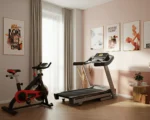When it comes to building a strong and sculpted back, few exercises rival the effectiveness of the diverging lat pulldown. This dynamic variation of the classic lat pulldown targets your latissimus dorsi (lats) while also engaging supporting muscles like your traps, rhomboids, and biceps. It’s a favorite among fitness enthusiasts, gym-goers, and athletes who aim to elevate their strength and aesthetics.
Here’s everything you need to know about the diverging lat pulldown, from its benefits to step-by-step guidance for proper execution.
What is a Diverging Lat Pulldown?
The diverging lat pulldown is a variation of the lat pulldown that involves handles or grips designed to move apart in a diverging motion. Unlike the conventional lat pulldown, where the handles move in a straight vertical path, this exercise introduces a unique movement pattern that more closely mimics the natural path of your arms during a pull-up or pull-down motion. This slight modification helps activate a broader range of muscles in your back and shoulders for unparalleled results.
Benefits of the Diverging Lat Pulldown
Why choose the diverging lat pulldown over its traditional counterpart? Here are a few standout benefits:
- Enhanced Muscle Activation: The diverging handles allow for a greater range of motion, engaging more muscle fibers in your back, shoulders, and arms.
- Improved Functional Strength: The natural movement pattern of the diverging handles mimics real-life pulling motions, improving functional strength and athletic performance.
- Balanced Muscle Development: By independently engaging each arm, this exercise helps correct muscle imbalances for a more symmetrical physique.
- Reduced Joint Strain: The diverging motion places less stress on the shoulder joints, making it a safer option for those with joint sensitivities.
- Greater Variety in Workouts: Adding this movement to your workout routine helps keep things fresh and challenges your muscles in new ways.
Muscles Worked
The diverging lat pulldown primarily targets your lats but also engages a variety of supporting muscles, including:
- Trapezius
- Rear Deltoids
- Rhomboids
- Biceps
- Core
- Pectorals (to a lesser degree)
How to Perform the Diverging Lat Pulldown
Before you get started, ensure the diverging lat pulldown machine is adjusted to fit your height and arm length. Here’s how to perform the exercise step-by-step:
- Adjust Your Setup
-
-
- Sit on the machine and position the padded thigh supports snugly against your legs. Ensure your feet are flat on the floor for stability.
- Set the appropriate weight that challenges you without compromising form.
-
- Grip the Handles
-
-
- Grasp the diverging handles with an overhand grip. Ensure your hands and shoulders are evenly aligned to avoid imbalances.
-
- Get in Position
-
-
- Keep your back straight and your chest slightly lifted. Avoid arching or rounding your back throughout the movement.
- Engage your core to maintain stability.
-
- Pull the Handles
-
-
- Slowly pull the handles downward and outward, following the natural diverging motion of the machine.
- Aim to bring the handles to chest level while squeezing your shoulder blades together at the bottom of the movement. Feel the contraction in your lats and supporting muscles.
-
- Return with Control
-
-
- Extend your arms upward as you guide the handles back to the starting position. Keep the movement controlled and avoid letting the weights slam down.
-
- Repeat
-
-
- Perform 8–12 repetitions for 3–4 sets, adjusting the weight as needed to maintain proper form.
-
Tips for Optimizing Your Diverging Lat Pulldown
- Maintain a Neutral Spine: Avoid leaning too far back or hunching forward. Keeping a neutral spine ensures maximum muscle engagement and minimizes the risk of injury.
- Go Slow: Controlled movements maximize muscle activation and prevent unnecessary momentum.
- Breathe Properly: Exhale during the pull phase and inhale as you return to the starting position.
- Focus on Mind-Muscle Connection: Concentrate on your back muscles doing the work rather than relying on your arms.
- Vary Your Grip: Experiment with wider or narrower grips to target different areas of your back.
How to Incorporate the Diverging Lat Pulldown into Your Routine
To get the most out of this exercise, consider incorporating it into your upper-body or pull-day workout. Here’s an example routine:
- Pull-Ups (3 sets of 10 reps)
- Diverging Lat Pulldown (4 sets of 8–12 reps)
- Cable Rows (3 sets of 10 reps)
- Face Pulls (3 sets of 12–15 reps)
- Dumbbell Bicep Curls (3 sets of 15 reps)
Rest for 60–90 seconds between sets, and adjust the weights based on your fitness goals (lighter weights for endurance, heavier weights for strength and mass).
Common Mistakes to Avoid
To perform the diverging lat pulldown effectively, steer clear of these common pitfalls:
- Using Excessive Weight: Choosing a weight that’s too heavy compromises form and increases injury risk.
- Leaning Back Too Far: While a slight lean is acceptable, excessive leaning shifts the focus from your lats to your lower back.
- Shortening the Range of Motion: Only pulling the handles halfway reduces muscle engagement. Always aim for a full range of motion.
- Overusing Momentum: Swinging your body to pull the weight negates the effectiveness of the exercise. Keep the movement controlled.
Final Thoughts on the Diverging Lat Pulldown
If you’re looking for an efficient, safe, and highly effective way to build a stronger back and improve overall functional strength, the diverging lat pulldown should be a staple in your routine. It’s a versatile exercise that offers all the benefits of a lat pulldown while introducing an optimized movement pattern for enhanced muscle activation.
For those ready to take their fitness to the next level, why not mix things up? Incorporate this move into your workouts and feel the difference it makes in your strength and aesthetic goals.
Looking for more workout tips and advice? Stay tuned, or reach out for custom training plans!








